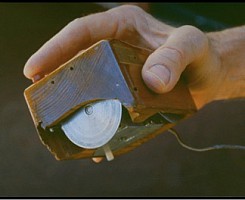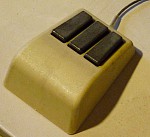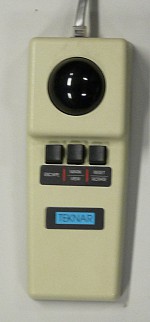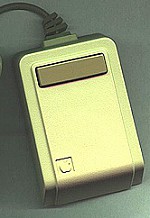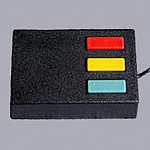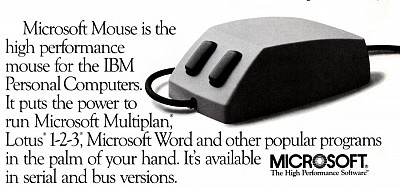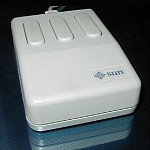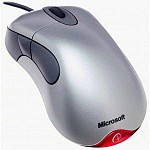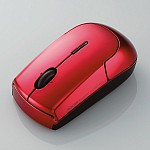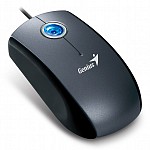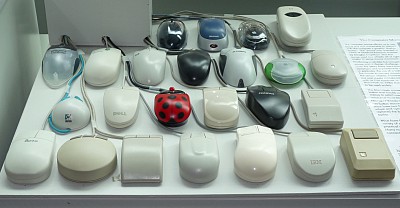Computer Science
Computing History Displays: Fifth Floor - The Computer Mouse
Beginnings
The mouse, the device by which we use hand and arm movements to interact with the graphical computer screen, has passed through some very definite stages of development that we will discuss later. Its conception and delivery are clear. The first mouse was designed by Douglas Engelbart as part of a research project investigating human/computer interaction at Stanford Research Institute in Menlo Park, California in 1964. Initially, it was a simple wooden box with two wheels underneath at right angles attached to potentiometers so that movement of the box over a surface could be sensed- there was also one button.
Although the mouse is a simple concept, the task of engineering a mouse that worked well was not easy - as we know today, a mouse that is not reliable is extremely frustrating. After its definite beginning, the mouse went into a 20-year period of refinement. It was further developed within SRI where the number of buttons grew to three and a ball under the mouse was used to transfer movement to the wheels. (This was an invention of Bill English, who also constructed the first mouse at SRI. )
Outside of SRI, the most important use of the mouse was at Xerox Palo Alto laboratories where the 3-button mouse was used in the Alto computer system that pioneered many of the aspects of the human/computer interface today. Although several thousand units were constructed, the Alto was not an external product. For this purpose Xerox introduced the Xerox Star computer that used a 2-button mouse, though this computer was not greatly successful.
At the time there were devices available other than mice that could be used to point at the screen. The earliest was the "track ball" - a ball fixed in place that could be rotated in any direction. The track ball could be used to make fine movements but the mouse is easier to use because it involves separate muscles in arm and fingers for the button. In a sense, the mouse with a ball is a track ball upside down (some modern mice have evolved to include a track ball and there are still track balls being sold, some called "stationary mice".) Another competing tool was the "light pen" that could be used to sense the beam on a raster screen as it "flashed by" and so identify a place or object on the screen. Compared to a mouse this is awkward to use involving a large arm movement that "gets in the way." So it was clear that, of these devices, the mouse was the best for general use. Introduction of the mouse was also inhibited by its control requiring quite a lot of computer power - this meant that it needed a powerful computer if it was to avoid causing a sluggish system.
Be that as it may, by 1983 the importance of the mouse and WIMP (Windows, Icons, Menus, Pointer) operating systems was widely recognized. "High-end" workstations using mice and graphical interfaces were available from a number of manufacturers but were too expensive for widespread personal use. Apple computer announced the Lisa computer in early 1983, delivering in the middle of the year. Lisa offered the functionality of a workstation at much lower cost though still at around $10,000US. Microsoft announced its first mouse, a 2-button model, in December 1983, to be used for specific applications delivered later.
Then came 1984! Apple computer introduced its Macintosh computer that introduced the modern GUI operating system, including mouse, at a price, around $2,500US that was low enough to create its own new market as a personal computer.
The Lisa and Macintosh mice were very similar in design. Apple turned to outside companies to develop mice for their computers - the successful designers were the start-up Hovey-Kelly which later became the design company IDEO. Their goal was to produce a mouse that had a manufacturing cost only 10% of others then available and be rugged and reliable as well. Their design was a great success, with the Macintosh mouse being the first manufactured in very large quantities.
One feature of the Macintosh mouse that was considered to be controversial was that it was restricted to having one button only - this requirement came right from the top, from Steve Jobs himself. The requirement was not solely to reduce cost - there was the danger with multiple buttons that different incompatible combinations of buttons would be used to control different programs - having one button caused control options to be selected from menus instead and promoted this approach to the human/computer interface. It was probably a very sound restriction at the time.
However, the single button did not provide enough immediate control when an object was located with the mouse pointer. An object could be selected with a click and opened using the convention of a "double click". Treble click is too fiddly to be used in any but special circumstances, so the Macintosh actual used variant clicks - holding a control key down when a click is made - to perform the very common task of finding out information about a selected object, often by means of a pop-up window. With two or more buttons this can be the function of the right button and this convention gradually became accepted. Apple finally joined this with the introduction of its Mighty Mouse in the 21st century.
The use of 2-button mice was promoted by Microsoft with its mouse of late 1983. However, it was not used widely until the arrival of Microsoft windows. In 1987 IBM also introduced a 2-button mouse with their PS/2 computer - this used an interface specification that became standard. Mice with 3 plain buttons were also available - these were commonly used with powerful graphics workstations. In the mid 1980s there were many manufacturers of mice, some of which were successful in the long-term. Three-button mice were offered by "The Mouse House" - a company started by Jack Hawley who worked on the design of mice for SRI and Xerox. The Swiss company Logitech developed mice based initially on a prototype from the Federal Institute of technology in Lausanne, starting shipping products in early 1983 - Logitech made mice into a very successful business and remains one of the major suppliers. Another important player was Mouse Systems, founded in 1982 by Steve Kirsch to market his invention of the optical mouse. These mice had to be used on a special pad marked with a very fine grid - they were commonly used in workstations. In 1990 Mouse Systems was incorporated into the Taiwanese company KYE which supplies mice under the Genius brand.
So, at the end of the 80s there were 3 main breeds of mice flourishing, 1-button with the Macintosh, 2-button with IBM PC and Windows, and 3 button (some optical) with workstations. The main technology development with mice during the 1980s was internal. The first inexpensive mice on the Macintosh had limited electronics and a parallel interface that simply provided two signals each for X and Y directions as well as the button. As microprocessors declined in price it became possible for each mouse to have its own - this enabled the mouse to be connected on a bus with a communications protocol and simple serial connection. In the case of Apple, this was the Macintosh desk-top bus, but the IBM PS/2 mouse offered similar functionality.
Although one moves the mouse as if its movement were "attached" to the cursor on the screen, the mouse does not communicate its position to the computer but rather information about how it has moved. A very simple mouse like that of the early Macintosh merely communicates that one of its wheels has rotated by one of the "notches" marked on the edge of the wheel. By using 4 sensors, 2 per wheel, and the technique of "quadrature", the computer can determine the direction of movement of each wheel. Every "notch" change has to be sensed within a strict time so that the speed of movement can be determined in order that software can move the cursor appropriately (usually faster mouse movement gives proportionately more cursor movement.) Controlling a simple mouse can be a burden on the smaller computers and if any "notch" change was missed the mouse movement could not be determined accurately. With an internal microprocessor devoted to controlling its mouse the real-time burden is off-loaded from the computer and the mouse can communicate the number of "notches" moved in X and Y directions and the amount of the movement. Mice as simple as those at the end of the 1980s are still available but most modern mice incorporate some or all of three improvements.
Scroll mouse
The scroll button - a wheel on the mouse moved by a finger, giving another series of movements to the computer - first appeared on the Pro-agio/Easyscroll mouse from "Mouse Systems"/"Genius" in 1995. This advance was cemented in place by Microsoft's Intellimouse of the following year. The idea of the scroll wheel came from Eric Michelman inside Microsoft. It became de-rigour when Microsoft extended its applications and Windows to interpret the scroll wheel movement. Generally, the scroll wheel movement causes information inside a window to move up or down, though in some applications the movement is taken to mean expansion or contraction of view. From the beginning, the scroll wheel could also be pressed as another button. This is now a standard feature and has eliminated the older 3-button mouse. The meaning of a press on the scroll button is not standardized but is often used to provide information on the computer system as a whole beyond the current application. All mice now have a scroll wheel or equivalent. Some mice have incorporated a track-ball instead, giving movement in any direction. The Apple "mighty mouse" has this ability now.
Wireless mouse
This is the same as an ordinary mouse except that it has no tail! The mouse communicates to the computer using radio or infra-red frequencies. This tends to be a more expensive option so is not universally used, though very common with laptop and notebook computers.
Optical mouse
The conventional mouse with a ball has the problem that the internal wheels gather dirt from the desktop and need to be cleaned regularly. The optical mouse as used in work stations was sealed and did not have this problem but had other defects, in particular requiring a special pad. The solution to this problem was provided by the optical mouse introduced by Agilent Technologies (a spin-of from Hewlett Packard) in 1999. This mouse used an LED inside the mouse to illuminate the surface underneath. A CMOS sensor effectively takes photographs of a small portion of the surface at a very fast rate - around 1500 per second. These are fed to an image processing chip in the mouse that applies algorithms to determine the direction of movement of the mouse as the picture changes. Almost any surface has enough texture for the mouse to operate though it can be fooled by a surface with no features at all. This technique was only made possible by progress in microelectronics allowing a cheap but powerful image processor to be developed. Such is the advantage of the optical mouse that it has now replaced the ball mouse for most applications.
In 2004 Logitech and Agilent further developed the optical mouse to use a laser rather than an LED - this allowed much finer positioning of the mouse. Laser mice are still a more-expensive option. Interestingly, although the problem of the dirty mice ball has been solved it has appeared again with mice such as the Mighty Mouse that incorporate a trackball rather than scroll wheels.
The mouse market is segmented by application. For general use with PCs an optical scroll wheel mouse is standard. For notebook computers, mice are available as accessories and tend to be wireless and compact, some even foldable. For "gamers" there is a range of fancy mice, usually laser-based, that have features such as extra buttons. There are many special mice that are ergonomically designed to reduce the incidence of repetitive strain injury. There are also mice, particularly those for use with notebooks, that include other features. There are keypad-mice and telephone-mice, for example.
There are other features and technology developments that have yet to have an impact. Many mice nowadays have extra buttons but there is no standard interpretation of their significance. There are mice that use inertial sensing of movement that are very sensitive to small wrist movements and do not have to be used on a flat surface. There are others that can detect the movement of the mouse in 3 dimensions but these have not yet made an impact (the only 3D device to gain traction is the Nintendo Wii which goes beyond a mouse in that it senses position rather than just movement.) There is talk of mice being replaced but there is no alternative at the moment that is having any inroads. Mice will be with us for a long time!

